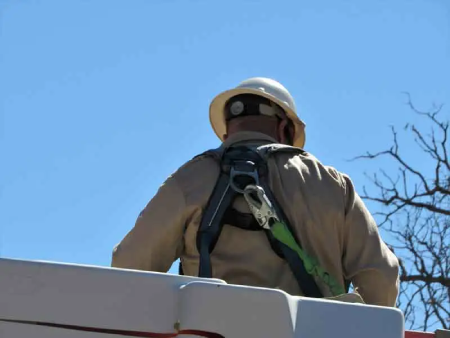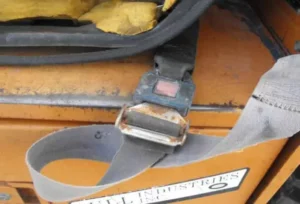
Continuing with our #hazardspotting posts, we have a new one. The failure to adhere to OSHA safety standards are rather apparent here, but are all too common on construction sites around the country. Spot the Hazards! #hazardspotting #spotthehazard #safetytraining
What potential hazards and safety issues do you see in this photo? Scroll down to see our own analysis.
Spot the Safety Hazards:

Scissor Lift Hazard Analysis:
What is wrong with this picture? Can you spot the hazards? And more importantly: do I even need to ask? Standing on the guardrails should not be done–end of story. Yes, their wearing fall arrest gear, but look even closer: the one guy isn’t even tied off (so what’s the point of wearing the harness?) while the other aerial lift worker is tied off to a guardrail and not to a designated anchor point. It is in violation of safety standards to tie off anywhere other than load rated points designated by the manufacturer. “But what about…” I often hear. No, there is not room for “buts” here. The guy is standing on the top rail fifty feet up on an extended section of a scissor lift without any protection.
More specifically regarding standing on guardrails, section 1926.453(b)(2)(iv) states that “employees shall always stand firmly on the floor of the basket, and shall not sit or climb on the edge of the basket or use planks, ladders, or other devices for a work position.” And for those who want to get technical and say this only applies to boom lifts because scissor lifts fall under the scaffold standard (29 CFR Part 1926 Subpart L (Scaffolds)), think again. In a letter of interpretation, OSHA notes that this type of behavior is most often not acceptable, even for scissor lifts. Additionally, just in case your not convinced, the OSH Act of 1970 is the catch-all here. That act specifically states, “each employer shall furnish to each of his employees employment and a place of employment which are free from recognized hazards that are causing or are likely to cause death or serious physical harm to his employees,” and that “each employee shall comply with occupational safety and health standards and all rules, regulations, and orders issued pursuant to this Act which are applicable to his own actions and conduct” (Section 5, Duties). If there was an accident and any one of these aerial lift operators was to fall to his injury or death, there is no way the individuals and/or company involved are not fined under the OSH Act, if not under other standards, for negligence and willful disregard for the regulations.
Furthermore
Another thing to note: I visit a lot of work sites–construction, maritime, warehouses, etc–and, believe it or not, I see this practice all of the time. In fact, I’d go so far as to say that 90% of the time I see aerial lift workers standing up on the rails at one time or another.
Every time I show aerial lift and scissor operators these types of pictures (and I have a ton of them!), they laugh. And why is it they laugh, you might ask? Well, in most cases, after talking to them further, they admit laughing because they, too, have done this once or twice or all the time. ‘Sometimes,’ I’ve heard them say, you gotta do what you gotta do to reach certain heights and get the job done.’ Okay, I get that to some extent, and I respect the drive that wants to get the job done, but I also make it very clear: OSHA or OHS, if you are in Canada, is not going to care. They will not praise you for being willing to put your life on the line to finish a job; instead, they will fine you for being careless and for being in such a hurry that you overlooked key safety regulations in the name of efficiency. If you can’t reach the spot intended with the work platform you have, you will need to get a bigger aerial lift or consider using a man-basket properly rigged and hoisted by a mobile crane. No amount of time or money saved is worth your life.
Visit us at Hard Hat Training for Scissor Lift and Fall Protection trainings. Good luck, and stay safe!
